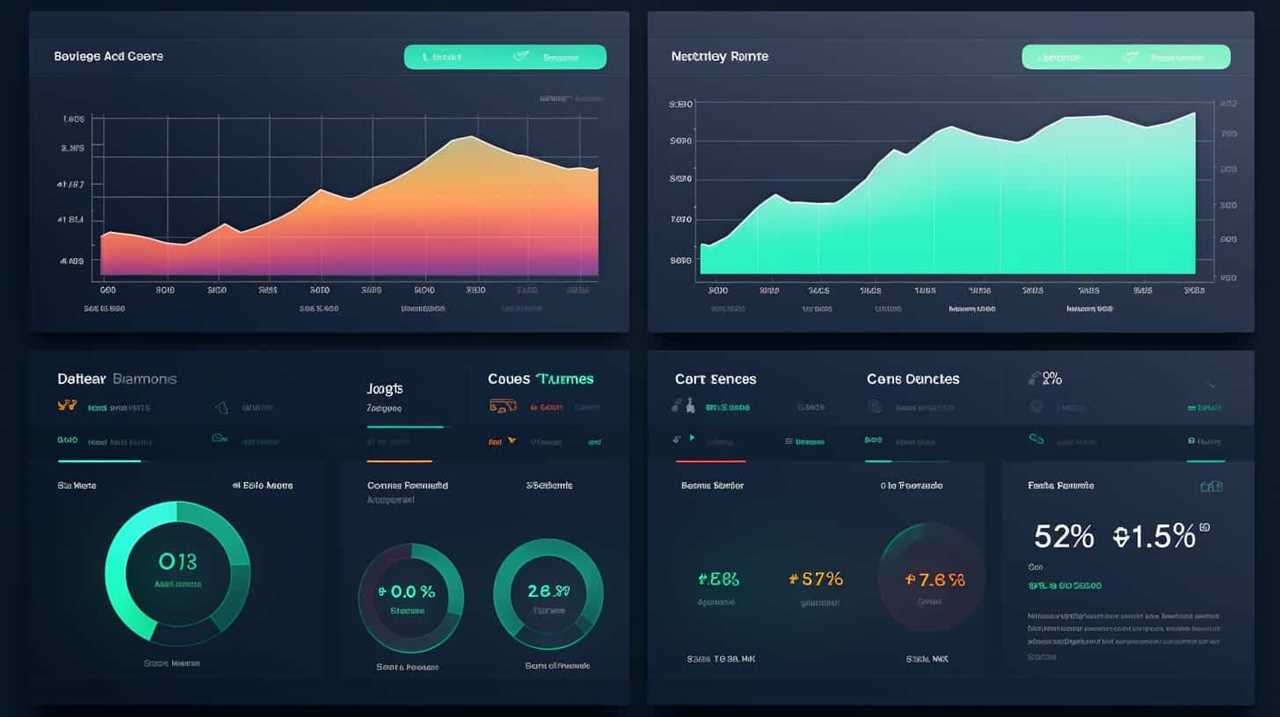Holistic SEO
SEO Branding: Carve Your Unique Identity in the Digital World

In today’s digital age, it’s crucial to create a unique identity for your brand.
That’s why we’re here to help you understand the power of SEO branding and how it can set you apart from the competition.
By defining your brand identity, identifying your target audience, and creating compelling content, you can make a lasting impression in the online realm.
And with the right strategies, like leveraging social media, you can achieve branding success that will truly make your mark.

Key Takeaways
- Implementing SEO strategies is essential for success in the digital landscape.
- Craft a clear and compelling message that resonates with the target audience.
- Tailor branding and marketing efforts to resonate with each target audience segment.
- Social media platforms enhance branding success and connect with the target audience.
Understanding SEO Branding
In understanding SEO branding, we focus on the importance of creating a distinct and recognizable identity in the digital world.
SEO strategies play a crucial role in achieving brand recognition and establishing a strong online presence. By implementing effective SEO techniques, businesses can optimize their websites and improve their visibility in search engine results.
This includes using relevant keywords, creating high-quality content, and building authoritative backlinks. These strategies help attract organic traffic and increase brand visibility, ultimately leading to higher conversion rates and business growth.
Additionally, SEO branding involves consistent brand messaging and positioning across all digital platforms. By aligning their online presence with their brand identity, businesses can build trust and loyalty with their target audience.

Understanding and implementing these SEO strategies is essential for any business looking to succeed in the competitive digital landscape.
Defining Your Unique Brand Identity
To establish our unique brand identity, we must craft a clear and compelling message that resonates with our target audience. Personal branding is the key to creating a distinct identity in the digital world. It involves shaping how others perceive us and our brand.
By defining our unique brand identity, we can differentiate ourselves from competitors and attract the right customers. Start by understanding our target audience and their needs. This will help us create a brand message that speaks directly to them.
We must also consider brand perception, as it plays a vital role in shaping our identity. Consistency in our messaging, visuals, and interactions is crucial for building a strong and recognizable brand.

With a well-defined brand identity, we can carve our place in the digital world.
Identifying Your Target Audience
We must identify our target audience to effectively carve our unique identity in the digital world. Market segmentation and customer profiling are crucial steps in this process.
Market segmentation involves dividing the market into distinct groups based on various factors such as demographics, interests, and behaviors. By understanding the different segments within our target market, we can tailor our branding and marketing efforts to resonate with each group.
Customer profiling goes a step further by creating detailed profiles of our ideal customers. This includes analyzing their demographics, psychographics, and purchasing behaviors. With customer profiling, we can gain deep insights into the needs, preferences, and motivations of our target audience, enabling us to create personalized experiences and content that truly resonates with them.

Creating Compelling and Consistent Content
Continuing from our previous discussion on identifying our target audience, let’s now delve into the importance of creating compelling and consistent content to effectively carve our unique identity in the digital world.
Content marketing plays a crucial role in brand storytelling, as it allows us to connect with our audience on a deeper level. By consistently producing valuable and engaging content, we can establish ourselves as industry leaders and build trust with our target audience.
High-quality content not only attracts and retains visitors to our website, but it also helps improve our search engine rankings. To ensure our content is compelling and consistent, we must have a clear brand voice, maintain a consistent tone, and deliver valuable information that resonates with our audience.
Leveraging Social Media for Branding Success
Social media platforms offer valuable opportunities for businesses to enhance their branding success. Leveraging social media engagement and influencer partnerships can help businesses establish a strong brand presence and connect with their target audience.

Here are four strategies to maximize social media for branding success:
- Consistent Brand Messaging: Maintain a consistent brand voice and messaging across all social media platforms to create a cohesive and recognizable brand identity.
- Engaging Content: Create and share high-quality, engaging content that resonates with your target audience. Use a mix of visuals, videos, and interactive elements to capture their attention and encourage social media interaction.
- Influencer Partnerships: Collaborate with influencers who align with your brand values and have a significant following. Their endorsement can help increase brand visibility and credibility.
- Social Listening: Monitor social media conversations and engage with your audience. Respond to comments, address concerns, and show appreciation for their support.
Frequently Asked Questions
How Long Does It Typically Take to See Results From SEO Branding Efforts?
Typically, it takes time to see results from SEO branding efforts. The SEO branding timeline varies depending on various factors. To measure SEO branding success, it’s important to track key metrics and analyze data regularly.
What Are Some Common Mistakes to Avoid When Defining Your Unique Brand Identity?
Common mistakes in defining your unique brand identity can hinder your branding success. By avoiding these pitfalls, we can ensure a strong and impactful brand that resonates with our target audience.
How Can I Effectively Identify My Target Audience in a Highly Competitive Market?
To effectively identify our target audience in a competitive market, we must conduct thorough market research, analyze customer data, and utilize tools like customer segmentation. Understanding our audience’s needs and preferences will help us tailor our branding and marketing strategies for maximum impact.

What Are Some Key Elements to Consider When Creating Compelling and Consistent Content?
When creating compelling and consistent content, we consider key elements such as the target audience, brand messaging, and SEO optimization. By focusing on content creation and brand consistency, we can effectively engage our audience in the digital world.
Which Social Media Platforms Are Most Effective for Branding Success, and Why?
When it comes to branding success on social media platforms, identifying your target audience is key. By creating compelling content and using effective strategies, we can carve our unique identity in the competitive market and achieve SEO branding results.
Conclusion
In conclusion, SEO branding is like carving a unique identity in the vast digital world.
It’s a process of understanding and defining your brand identity, identifying your target audience, and creating consistent and compelling content.

By leveraging the power of social media, you can achieve branding success and stand out from the crowd.
Just like a master sculptor carefully crafts a masterpiece, with SEO branding, you can shape your brand into something distinctive and unforgettable.
Holistic SEO
SEO Consistency for Success: 10 Tips to Enhance Your Content Game

Feeling worn out from producing content that fails to achieve your expected outcomes? Here’s some news for you. Achieving success in SEO is not a matter of chance or random guessing. It’s all about being consistent.
And lucky for you, we’ve got 10 tips to help you enhance your content game and achieve the success you’ve been dreaming of. So buckle up, because we’re about to take your SEO skills to the next level. Let’s dive in!
Key Takeaways
- Personalize content to capture and engage the audience.
- Conduct competitor analysis to gain insights and identify improvement opportunities.
- Utilize a long-tail keyword strategy to target a narrower audience.
- Regularly produce and publish high-quality content that aligns with audience interests.
Understand Your Target Audience
To achieve SEO consistency for success, we must begin by thoroughly understanding our target audience. Personalizing content is crucial in capturing the attention of our audience and keeping them engaged.
By conducting competitor analysis, we can gain insights into what works for our competitors and identify opportunities for improvement. This allows us to create content that stands out and meets the specific needs of our audience.

Understanding our target audience also helps us tailor our messaging and language to resonate with them on a deeper level. By knowing their demographics, preferences, and pain points, we can craft content that addresses their specific concerns and offers valuable solutions.
Ultimately, this personalized approach won’t only boost our SEO efforts but also enhance overall customer satisfaction and loyalty.
Conduct Thorough Keyword Research
For successful SEO consistency, we enhance our content game by conducting thorough keyword research. Keyword research is crucial because it helps us understand what our target audience is searching for and allows us to optimize our content accordingly.
Here are four essential tips for conducting effective keyword research:

- Utilize a long tail keyword strategy: Long tail keywords are longer and more specific phrases that target a narrower audience. They’ve less competition and can help us rank higher in search engine results.
- Perform competitor analysis: By analyzing our competitors’ keywords, we can gain insights into their strategies and discover new keyword opportunities.
- Use keyword research tools: Tools like Google Keyword Planner, SEMrush, and Moz Keyword Explorer can provide valuable data on search volume, competition, and related keywords.
- Consider user intent: Understanding the intent behind specific keywords helps us create content that aligns with what users are looking for.
Optimize Your On-Page SEO Elements
After conducting thorough keyword research, we can now optimize our on-page SEO elements to further enhance our content game.
To improve page structure, ensure that your content is well-organized and easy to navigate. Use clear headings and subheadings that include relevant keywords.
Additionally, optimize your meta descriptions to entice users to click on your website in search results. Write concise and compelling descriptions that accurately summarize the content on each page. Include relevant keywords naturally, but avoid keyword stuffing. Meta descriptions should be around 150-160 characters long and provide a clear and concise preview of what users can expect when they visit your page.
Focus on Creating High-Quality Content
Our team’s focus is on creating high-quality content to drive SEO success. To achieve this, we employ several strategies that ensure our content stands out and resonates with our audience:

- Thorough Research: We conduct extensive research to understand our target audience’s needs, interests, and pain points. This enables us to create content that’s relevant and valuable to them.
- Compelling Writing: We strive to craft engaging and persuasive content that captivates readers from the very beginning. By using storytelling techniques, we can effectively communicate our message and evoke emotions.
- Visual Appeal: We understand the importance of visual content in capturing attention and enhancing engagement. Incorporating relevant images, infographics, and videos can make our content more appealing and shareable.
- Effective Distribution: We implement effective content distribution strategies to ensure our high-quality content reaches a wider audience. This includes leveraging social media platforms, email marketing, guest posting, and collaborating with influencers.
Maintain a Consistent Publishing Schedule
To ensure the success of our SEO efforts, it’s crucial to maintain a consistent publishing schedule. Consistent content refers to regularly producing and publishing high-quality articles, blog posts, videos, or any other form of content that aligns with our target audience’s interests and needs.
Maintaining a consistent publishing schedule helps build credibility and trust with our audience, as they come to expect new and valuable content from us on a regular basis. It also signals to search engines that our website is active and relevant, which can positively impact our SEO rankings.
However, consistency doesn’t mean sacrificing quality for quantity. It’s important to find a balance between publishing frequency and the quality of our content. By planning and organizing our content creation process, we can ensure that we consistently deliver valuable and engaging content to our audience.
Utilize Internal and External Linking
We can enhance our SEO efforts by utilizing internal and external linking to further boost our content’s visibility and authority. Link building strategies play a crucial role in improving search engine rankings and driving organic traffic to our website.

Here are some key tips to consider:
- Internal linking: Link relevant pages within our website to improve user navigation and encourage visitors to explore more of our content.
- External linking: Include outbound links to high-quality websites that are relevant to our content, which can increase our website’s credibility and authority.
- Anchor text optimization: Use descriptive and keyword-rich anchor text when linking to other pages, as it helps search engines understand the context and relevance of the linked page.
- Broken link monitoring: Regularly check for broken links within our website and fix them promptly to provide a seamless user experience.
By implementing these link building strategies and understanding the importance of anchor text, we can strengthen our SEO efforts and improve our content’s visibility.
Now, let’s discuss how we can optimize our website’s loading speed.
Optimize Your Website’s Loading Speed
To further enhance our SEO efforts and ensure a seamless user experience, optimizing our website’s loading speed is crucial. A slow-loading website can have a negative impact on both SEO rankings and user satisfaction.

To improve website security and enhance user experience, we need to focus on reducing page load times. One effective way to achieve this is by optimizing image sizes and formats. Compressing images without compromising quality can significantly decrease loading times.
Additionally, minimizing the use of external scripts and plugins can help streamline the loading process. Furthermore, leveraging browser caching and content delivery networks (CDNs) can further improve loading speed.
Regularly monitoring and optimizing website performance will ensure that our website remains fast and efficient, ultimately leading to better SEO results and happier users.
Leverage Social Media for Content Promotion
When it comes to promoting our content, leveraging social media is crucial.

Social media platforms offer a vast audience and allow us to connect with our target market directly.
Social Media Promotion Strategies
By leveraging social media for content promotion, businesses can greatly enhance their SEO consistency and overall success. Social media engagement and influencer marketing strategies play a crucial role in maximizing the impact of your content. Here are four key strategies to consider:
- Create shareable content: Craft compelling and valuable content that resonates with your target audience. This will encourage social media users to engage with and share your content, increasing its reach and visibility.
- Utilize influencers: Collaborate with influencers in your industry who have a strong social media presence and a large following. By partnering with them, you can tap into their audience and gain exposure to a wider range of potential customers.
- Encourage user-generated content: Encourage your audience to create and share content related to your brand. This not only fosters engagement but also helps generate authentic and trusted content that can boost your SEO efforts.
- Engage with your audience: Actively participate in conversations, respond to comments, and ask for feedback. Building a strong relationship with your audience won’t only drive engagement but also increase brand loyalty and trust.
Implementing these social media promotion strategies will help amplify your content and improve your overall SEO consistency.
Maximizing Content Reach
We can continue the conversation about maximizing content reach by leveraging social media for content promotion.

Social media platforms offer an incredible opportunity to increase audience engagement and maximize content visibility. With billions of active users on platforms like Facebook, Instagram, Twitter, and LinkedIn, the potential reach for your content is immense. By strategically promoting your content on these platforms, you can reach a wider audience and drive more traffic to your website.
Social media allows you to interact directly with your audience, build relationships, and encourage them to share your content with others. Utilize features such as hashtags, tagging relevant users or accounts, and creating compelling visuals to capture your audience’s attention. By consistently sharing valuable content and engaging with your audience, you can build a loyal following and increase your content’s visibility.
Now let’s explore how you can monitor and analyze your SEO performance to ensure your efforts are paying off.
Monitor and Analyze Your SEO Performance
Now that we’ve covered leveraging social media for content promotion, let’s shift our focus to monitoring and analyzing our SEO performance.

To ensure success, it’s crucial to track keyword rankings, analyze traffic sources, and monitor our backlink profile. By consistently monitoring these factors, we can gain insights into what’s working and what needs improvement, allowing us to make data-driven decisions and optimize our SEO strategy for maximum impact.
Track Keyword Rankings
To effectively monitor and analyze our SEO performance, it’s important that we track keyword rankings. Keyword tracking allows us to understand how well our content is performing in search engine results pages (SERPs) and make informed decisions to improve our SEO strategy.
Here are four key reasons why tracking keyword rankings is crucial for success in SEO analytics:
- Identify top-performing keywords: Tracking keyword rankings helps us identify which keywords are driving the most traffic and conversions, allowing us to focus our efforts on optimizing for those keywords.
- Spot trends and opportunities: By tracking keyword rankings over time, we can identify trends and opportunities that may arise, such as emerging keywords or shifts in search behavior, allowing us to stay ahead of the competition.
- Measure SEO campaign effectiveness: Keyword tracking allows us to measure the effectiveness of our SEO campaigns and tactics, helping us determine what works and what needs improvement.
- Track competitor performance: By monitoring our keyword rankings alongside our competitors, we can gain valuable insights into their SEO strategies and identify areas where we can outperform them.
Analyze Traffic Sources
One crucial aspect of monitoring and analyzing our SEO performance is to analyze traffic sources. By analyzing traffic patterns, we can gain valuable insights into where our website traffic is coming from and how users are finding our content.

This information allows us to identify referral sources, such as search engines, social media platforms, or other websites that are driving traffic to our site. By understanding which sources are bringing in the most traffic, we can optimize our SEO strategy to further enhance our online presence.
Analyzing traffic sources also helps us identify any potential issues or areas for improvement. By regularly monitoring and analyzing our SEO performance, we can make informed decisions to continuously optimize our content and drive more targeted traffic to our website.
Monitor Backlink Profile
By monitoring our backlink profile, we can gain valuable insights into the quality and quantity of websites linking to our content, allowing us to analyze and optimize our SEO performance. Backlink analysis plays a crucial role in understanding the authority and relevance of our website in the eyes of search engines.
Here are some key benefits of monitoring our backlink profile:

- Identify high-quality backlinks: By analyzing our backlink profile, we can identify authoritative websites that are linking to our content. This helps us understand which websites are endorsing our content, boosting our credibility and improving our SEO rankings.
- Uncover low-quality backlinks: Monitoring our backlink profile also allows us to identify any low-quality or spammy websites that are linking to us. By disavowing these backlinks, we can protect our website from any potential penalties and maintain a strong online reputation.
- Conduct competitor analysis: Monitoring our backlink profile enables us to compare our backlinks with those of our competitors. This helps us understand the strategies they’re using to build backlinks and gives us insights into potential opportunities for improvement.
- Optimize link-building efforts: By regularly monitoring our backlink profile, we can identify any gaps or areas for improvement in our link-building strategy. This allows us to focus our efforts on acquiring high-quality backlinks from relevant and authoritative websites.
Stay Updated With SEO Trends and Algorithms
As digital marketers, we must constantly stay updated with the ever-changing SEO trends and algorithms to ensure our content remains relevant and optimized. SEO algorithm updates can greatly impact our website’s visibility and rankings, so it’s crucial to stay informed. By keeping up with the latest SEO best practices, we can effectively optimize our content and improve our chances of ranking higher in search engine results pages.
Here are three key SEO trends and algorithms that we should pay attention to:
| Trends and Algorithms | Description | Impact |
|---|---|---|
| Mobile-first indexing | Search engines prioritize mobile-friendly websites and mobile user experience. | Non-mobile optimized sites may see a decrease in rankings and visibility. |
| Voice search optimization | More users are relying on voice assistants like Siri and Alexa to find information. | Optimizing content for voice search can improve visibility and attract voice search traffic. |
| Core Web Vitals | Google’s page experience update focuses on user experience metrics like loading speed and interactivity. | Websites that provide a better user experience may see an increase in rankings and visibility. |
Frequently Asked Questions
How Can I Determine Who My Target Audience Is?
Identifying demographics and surveying potential customers helps us determine our target audience. By understanding their needs and preferences, we can create content that resonates with them and drives success in our SEO efforts.
What Are Some Effective Strategies for Conducting Keyword Research?
When it comes to conducting keyword research, effective strategies include competitor analysis to see what keywords they’re targeting, and focusing on long tail keywords that have less competition but higher conversion rates.

How Can I Optimize My Website’s Loading Speed?
To optimize our website’s loading speed, we focus on improving website performance and enhancing user experience. We implement strategies like compressing images, minifying CSS and JavaScript, and leveraging browser caching for faster load times.
What Are Some Best Practices for Leveraging Social Media for Content Promotion?
Social media engagement and influencer partnerships are crucial for successful content promotion. We’ll share tips on how to effectively leverage social media, maximizing reach and engagement, in our guide on enhancing your content game.
How Can I Stay Updated With the Latest SEO Trends and Algorithms?
To stay updated with the latest SEO trends and algorithms, we can engage in SEO training and regularly read SEO blogs. This ensures we have the knowledge and tools to optimize our content effectively.
Conclusion
In the journey of SEO, consistency is the key to success. Just like the gears in a well-oiled machine, each tip mentioned above plays a vital role in enhancing your content game.

By understanding your target audience, conducting thorough keyword research, and optimizing your on-page elements, you can create high-quality content that resonates with your audience.
With a consistent publishing schedule, fast-loading website, and leveraging social media for promotion, you can monitor and analyze your SEO performance to stay updated with the ever-evolving trends and algorithms.
Stay consistent, stay ahead.
Holistic SEO
10 Best Strategies for Implementing Holistic SEO

- Keyword placement: How to strategically place keywords in title tags and meta descriptions for maximum impact.
- Writing compelling copy: Tips for crafting enticing title tags and meta descriptions that attract both search engines and users
Searching for ways to improve your SEO capabilities? Look no further – this comprehensive guide is designed specifically for you.
In this article, we’ll share the 10 best strategies for implementing holistic SEO that will skyrocket your website’s visibility and rankings.
From keyword research to continuous monitoring and optimization, we’ve got you covered.
So grab a cup of coffee, sit back, and get ready to master the art of holistic SEO.

Let’s dive in!
Key Takeaways
- Prioritize identifying high-volume keywords relevant to the target audience.
- Optimize keyword placement in website content for maximum impact.
- Conduct keyword research to identify relevant keywords for content optimization.
- Implement responsive web design for optimal user experience on mobile devices.
Keyword Research
When conducting keyword research for holistic SEO implementation, we should prioritize identifying high-volume keywords that are relevant to our target audience.
One effective strategy is to perform competitor analysis to gain insights into the keywords that our competitors are targeting. By understanding what keywords they’re ranking for, we can identify opportunities to optimize our own content and gain a competitive edge.
Additionally, it’s essential to consider long tail keywords, which are longer and more specific phrases that have lower search volume but higher conversion rates. These keywords allow us to target a specific audience and capture highly qualified leads.

On-Page Optimization
When it comes to on-page optimization, there are two key points to consider: the importance of meta tags and content optimization tips.
Meta tags play a crucial role in helping search engines understand the content of a webpage, so it’s essential to optimize them with relevant keywords and accurate descriptions.
Content optimization involves creating high-quality, informative, and engaging content that’s optimized for both users and search engines.
Meta Tags Importance
Implementing holistic SEO requires understanding the importance of meta tags for on-page optimization. Meta tags provide information to search engines about the content of your web page, helping them to understand what your page is about and how it should be ranked.

Here are some best practices for meta tag optimization:
- Meta Descriptions: Writing compelling and relevant meta descriptions can increase the click-through rate of your website in search engine results. It’s important to include relevant keywords and a clear call-to-action to entice users to click on your link.
- Title Tags: Your title tags should accurately describe the content of your page and include relevant keywords. It’s recommended to keep your title tags between 50-60 characters to ensure they’re fully displayed in search results.
- Meta Keywords: While meta keywords aren’t as important as they used to be, it’s still worth including relevant keywords that describe the content of your page. However, avoid keyword stuffing as it can have a negative impact on your SEO.
Content Optimization Tips
Continuing the discussion on on-page optimization, let’s explore some effective content optimization tips for holistic SEO.
When it comes to content promotion, it’s crucial to create high-quality, valuable content that meets the needs of your target audience.
Start by conducting keyword research to identify relevant keywords and incorporate them naturally throughout your content.

Utilize SEO tools like Google Analytics and SEMrush to track the performance of your content and make data-driven decisions.
Additionally, optimize your title tags, meta descriptions, and headings to improve your website’s visibility in search engine results.
Don’t forget to optimize your images by using alt tags and compressing their file sizes for faster loading times.
Technical SEO
One important aspect of achieving holistic SEO is by effectively incorporating technical SEO strategies. Technical SEO focuses on optimizing the technical aspects of a website to improve its search engine visibility and user experience.

To implement technical SEO effectively, consider the following strategies:
- Conduct an SEO audit and analysis: Start by evaluating your website’s current technical performance and identifying areas that need improvement. This includes analyzing site speed, mobile-friendliness, URL structure, and crawlability.
- Optimize website speed: Website speed is crucial for both search engine rankings and user experience. Minimize file sizes, leverage browser caching, and optimize code to improve loading times.
- Ensure mobile-friendliness: With the majority of internet users accessing websites through mobile devices, it’s essential to have a responsive design that adapts to different screen sizes. Test your website on various devices to ensure a seamless mobile experience.
Content Creation and Optimization
When it comes to content creation and optimization for SEO, we need to focus on quality over quantity. While it’s important to have a sufficient amount of content to rank well in search engines, it’s even more crucial to ensure that the content is valuable, relevant, and engaging to users.
Additionally, keyword research techniques play a vital role in optimizing content for SEO. By identifying the right keywords and incorporating them strategically throughout the content, we can increase the visibility and relevance of our website in search results.
Quality Vs Quantity
To effectively implement holistic SEO, we prioritize quality over quantity in content creation and optimization. While it may be tempting to churn out a large quantity of content to improve search engine rankings, focusing on quality is key to long-term success. Here’s why:

- User Engagement: High-quality content is more likely to engage users, keeping them on your site longer and reducing bounce rates. This signals to search engines that your website is valuable and deserving of a higher ranking.
- Reputation Building: Quality content helps establish your brand as a trusted authority in your industry. This can lead to increased brand awareness, credibility, and ultimately, more organic traffic.
- Link Building: Valuable, well-researched content is more likely to attract high-quality backlinks from other reputable websites. These backlinks are crucial for improving your website’s domain authority and search engine rankings.
Keyword Research Techniques
Now that we’ve prioritized quality over quantity in content creation and optimization, let’s delve into the effective keyword research techniques for holistic SEO.
One of the first steps in keyword research is conducting competitor analysis. By analyzing the keywords your competitors are targeting, you can gain valuable insights and identify opportunities for your own content.
Additionally, focusing on long tail keywords can help you target specific and niche audiences, resulting in higher conversion rates. Long tail keywords are longer and more specific phrases that have lower competition but higher intent. By incorporating these keywords into your content, you can attract highly motivated visitors who are more likely to engage with your website.
With a solid understanding of competitor analysis and long tail keywords, you can optimize your content to reach the right audience and improve your search engine rankings.

Now, let’s move on to the next section, where we’ll explore the importance of user experience and website design in holistic SEO.
User Experience and Website Design
Our research has revealed that implementing user-friendly website design is a crucial aspect of holistic SEO strategy. The user experience and website design play a significant role in user engagement and overall website performance.
Here are three key factors to consider when optimizing user experience and website design:
- Visual Appeal: A visually appealing website design captures users’ attention and encourages them to stay longer on your site. Using high-quality images, clear typography, and a clean layout can enhance the visual appeal of your website.
- Easy Navigation: A well-structured and intuitive navigation system allows users to find the information they need quickly and easily. Implementing clear menus, breadcrumbs, and search functionality can help improve user experience and reduce bounce rates.
- Mobile Responsiveness: With the increasing use of mobile devices, it’s crucial to ensure that your website is mobile-friendly. Responsive design allows your website to adapt to different screen sizes, providing a seamless experience for users on any device.
Mobile-Friendliness
When it comes to implementing holistic SEO, one crucial aspect to consider is mobile-friendliness.

With the rise of mobile devices, it’s essential to ensure that your website is optimized for mobile users. This can be achieved through responsive web design and mobile site optimization.
Responsive Web Design
To achieve optimal results in holistic SEO, we prioritize implementing responsive web design for mobile-friendliness. With the increasing use of smartphones and tablets, it’s crucial to ensure that your website is accessible and user-friendly across different devices.
Here are three reasons why responsive web design is essential for mobile-friendliness:
- Improved User Experience: Responsive design ensures that your website adapts to different screen sizes, providing a seamless browsing experience for mobile users. This leads to increased engagement, lower bounce rates, and higher conversion rates.
- Better SEO Performance: Google prioritizes mobile-friendly websites in search engine rankings. By implementing responsive design, you enhance your chances of ranking higher and driving organic traffic to your site.
- Cost and Time Efficiency: Responsive design eliminates the need for separate mobile app development, saving you time and resources. It also simplifies website speed optimization, as there’s only one version of your site to optimize.
Mobile Site Optimization
Implementing mobile site optimization is crucial for holistic SEO because it ensures that your website is mobile-friendly and accessible to a wider audience. In today’s digital landscape, more and more people are using their smartphones and tablets to browse the internet. Therefore, it’s essential that your website is optimized for mobile devices to provide a seamless user experience.

Two important aspects of mobile site optimization are mobile site speed and mobile site navigation. Mobile site speed refers to how quickly your website loads on mobile devices. A slow-loading website can frustrate users and lead to high bounce rates. On the other hand, a fast-loading website can improve user experience and increase the likelihood of conversions.
Mobile site navigation refers to how easily users can navigate your website on mobile devices. It’s important to prioritize simplicity and ease of use, ensuring that visitors can find the information they’re looking for quickly and effortlessly.
By optimizing your website for mobile devices, you can reach a larger audience and improve your website’s visibility in search engine rankings. This will ultimately lead to increased traffic and better overall SEO performance.
Now that we’ve discussed the importance of mobile site optimization, let’s move on to the next section: link building and outreach.

Link Building and Outreach
Effective link building and outreach are essential components of a holistic SEO strategy. By strategically building links and reaching out to relevant sources, you can improve your website’s visibility and authority, ultimately boosting its search engine rankings. Here are three key strategies to consider:
- Develop high-quality content:
Creating valuable and shareable content is crucial for attracting natural backlinks. Focus on producing informative articles, engaging videos, and helpful resources that other websites would want to link to. - Guest blogging:
Writing guest posts for reputable websites in your industry is an effective way to build quality backlinks. It allows you to showcase your expertise and reach a wider audience while earning valuable links back to your site. - Influencer outreach:
Collaborating with influencers and industry experts can help you gain exposure and build authoritative links. Reach out to relevant influencers, offer valuable content or partnerships, and leverage their networks to amplify your brand’s reach.
By implementing these link building strategies and outreach techniques, you can enhance your website’s visibility and credibility.
Now, let’s delve into the next section about social media integration.
SUBSEQUENT SECTION: ‘Social Media Integration’
Social Media Integration
Our approach to social media integration revolves around utilizing its potential to enhance our holistic SEO strategy. Social media engagement plays a crucial role in driving organic traffic and improving search engine rankings. By incorporating social media marketing strategies into our SEO efforts, we can amplify our brand’s reach and visibility.

Through regular content sharing, community building, and active engagement with our audience, we can create a strong online presence that not only attracts more visitors but also encourages them to interact and share our content. This increased engagement signals to search engines that our website is valuable and relevant, ultimately boosting our SEO performance.
Analytics and Reporting
To accurately measure the impact of our social media integration efforts, we rely on analytics and reporting to provide us with valuable data and insights. Data analysis plays a crucial role in understanding the performance of our SEO strategies and optimizing them for better results.
Here are three key reasons why analytics and reporting are essential for effective SEO implementation:
- Tracking Performance: Analytics allows us to monitor the performance of our website and individual pages, providing us with valuable information on user behavior, traffic sources, and conversion rates. By analyzing this data, we can identify areas of improvement and make data-driven decisions to enhance our SEO efforts.
- Identifying Trends: Through data analysis, we can uncover trends and patterns in user behavior, keyword rankings, and content performance. This helps us identify opportunities for optimization and adjust our SEO strategies accordingly.
- Measuring ROI: Analytics and reporting enable us to measure the return on investment (ROI) of our SEO initiatives. By tracking key metrics such as organic traffic, leads generated, and revenue generated, we can determine the effectiveness of our SEO efforts and justify our investment in holistic SEO.
Continuous Monitoring and Optimization
By implementing continuous monitoring and optimization, we can ensure that our SEO strategies remain dynamic and responsive to the ever-changing digital landscape.

Continuous improvement is vital in the world of SEO, as algorithms and trends are constantly evolving. Through regular monitoring of our website’s performance, we can identify areas of improvement and make necessary adjustments to enhance our online visibility and rankings.
A/B testing is another powerful tool we can utilize to optimize our SEO efforts. By testing different versions of our website, content, or marketing campaigns, we can gather valuable data and insights to determine which strategies are most effective in driving traffic and conversions.
This data-driven approach allows us to make informed decisions and refine our SEO strategies for maximum impact.
With continuous monitoring and optimization, we can stay ahead of the game and achieve long-term success in the competitive world of SEO.

Frequently Asked Questions
How Can I Determine the Right Keywords to Target for My Website?
To determine the right keywords for your website, we use keyword research tools and employ SEO keyword optimization. By analyzing search volume, competition, and relevance, we identify the most effective keywords to target for optimal website performance.
What Are Some Best Practices for Optimizing On-Page Elements Like Title Tags and Meta Descriptions?
Optimizing on-page elements like title tags and meta descriptions is crucial for improving SEO. We’ll discuss how to strategically place keywords and craft enticing copy that attracts both search engines and users.
How Can I Improve the Technical Aspects of My Website, Such as Site Speed and Crawlability?
To improve website performance and enhance accessibility, we focus on optimizing site speed and crawlability. By implementing techniques such as optimizing images, minifying code, and improving server response time, we can ensure a smooth and efficient user experience.
What Are Some Strategies for Creating Quality Content That Both Search Engines and Users Will Love?
Creating engaging content that incorporates multimedia is crucial for both search engines and users. By focusing on high-quality, informative content, we can optimize our website for better visibility and user experience.

How Can I Ensure That My Website Offers a Great User Experience and Is Visually Appealing in Terms of Design?
To ensure a visually appealing website design and great user experience, we focus on creating a seamless interface with intuitive navigation, engaging visuals, and responsive layouts that adapt to different devices.
Conclusion
Implementing holistic SEO is like nurturing a thriving garden.
By carefully choosing the right keywords, optimizing on-page elements, and ensuring technical excellence, we lay the foundation for success.
Creating quality content, designing user-friendly websites, and building strong connections through link building and social media integration are the seeds that grow into fruitful results.

With continuous monitoring and optimization, we cultivate a flourishing online presence that delights both search engines and users alike.
Together, we can transform your website into a vibrant digital sanctuary.
Holistic SEO
7 Best Ways Voice Search Influences Holistic SEO

Exploring the domain of comprehensive SEO, we discover an innovative power that’s transforming the digital scene: voice search. This capacity to revolutionize the user experience calls for our focus.
Through this article, we explore seven best ways in which voice search influences SEO strategies. From the importance of long-tail keywords to the rise of featured snippets, we unveil the secrets to optimizing for this emerging era.
Join us on this journey towards mastery in the realm of voice search and holistic SEO.
Key Takeaways
- Voice search optimization improves website visibility and organic traffic
- Optimizing for long-tail keywords and natural language is crucial for voice search optimization
- Voice search has a direct impact on local SEO and business listings
- Mobile optimization is essential for voice search, as the majority of voice searches are conducted on smartphones.
Enhanced User Experience Through Voice Search
We have found that voice search enhances the user experience by providing faster and more convenient access to information. With the advancements in natural language processing and voice search analytics, users can now interact with their devices in a more conversational and intuitive manner.

This means that instead of typing in a search query, users can simply speak their requests, allowing for a more seamless and efficient search experience. Voice search also eliminates the need to navigate through multiple pages of search results, as the device can provide the most relevant information directly.
This not only saves time but also improves user satisfaction. By incorporating voice search into our SEO strategies, we can cater to the needs and preferences of our audience, ultimately enhancing their overall experience.
Increased Importance of Long-Tail Keywords
The growing prominence of voice search necessitates a shift towards prioritizing long-tail keywords for a more targeted and effective SEO strategy. As voice search continues to rise in popularity, it is important for businesses to adapt their keyword strategies to align with voice search optimization. Long-tail keywords, which are longer and more specific phrases, are becoming increasingly important in capturing voice search queries. These keywords allow businesses to target a more niche audience and improve their chances of appearing in voice search results. To illustrate this shift, consider the following table:
| Traditional Keywords | Long-Tail Keywords |
|---|---|
| Buy shoes | Buy men’s running shoes |
| Hotel | Luxury beachfront hotel |
| Recipe | Healthy vegan dessert recipe |
| Laptop | Lightweight gaming laptop |
| Workout | HIIT workout for beginners |
As voice search trends continue to evolve, incorporating long-tail keywords into your SEO strategy will be crucial for staying competitive and reaching your target audience effectively.

Need for Conversational Content Optimization
To ensure optimal results in voice search rankings, it’s imperative to implement conversational content optimization strategies. With the rise of voice search and natural language processing, it’s crucial to create content that mirrors the way people speak and ask questions. This means focusing on long-tail keywords and incorporating conversational phrases and queries into your content.
By doing so, you can improve your website’s visibility and attract more voice search users. Additionally, conversational content optimization can enhance the user experience and increase conversion rates. By understanding how people naturally speak and tailoring your content to match their language patterns, you can create a more engaging and interactive experience for your audience.
This, in turn, can lead to higher customer satisfaction and increased conversion rates. So, don’t underestimate the power of conversational content optimization in improving your voice search rankings and overall SEO strategy.
Rise of Featured Snippets in Voice Search Results
Featured snippets are becoming increasingly prominent in voice search results. As voice search optimization continues to gain importance, it’s crucial for businesses to understand the impact of featured snippets on their SEO strategies.

Voice assistants like Siri, Alexa, and Google Assistant often rely on featured snippets to provide quick and concise answers to user queries. These snippets appear at the top of search engine results pages (SERPs) and are designed to provide immediate information.
Therefore, optimizing content for featured snippets can significantly enhance visibility in voice search results. By focusing on creating high-quality, concise, and informative content that directly answers user questions, businesses can increase their chances of being featured in voice search results.
Now, let’s explore the impact of featured snippets on local SEO and business listings.
Impact on Local SEO and Business Listings
As we delve into the impact of featured snippets on local SEO and business listings, it’s important to understand how optimizing for voice search can significantly enhance visibility for businesses.

Voice search optimization for mobile devices is becoming increasingly crucial as more and more people use voice assistants like Siri, Alexa, and Google Assistant to find local businesses. By incorporating relevant keywords and phrases into their website content, businesses can improve their chances of appearing in voice search results.
Additionally, voice search and the future of SEO strategy go hand in hand when it comes to local SEO and business listings. As voice search continues to evolve and become more prevalent, businesses that prioritize optimizing for voice search will have a competitive edge in the digital landscape.
It’s essential for businesses to adapt their SEO strategies to ensure they’re effectively targeting voice search users and maximizing their visibility in local search results.
Frequently Asked Questions
How Does Voice Search Enhance the User Experience?
Using voice search enhances the user experience by improving accessibility and increasing engagement. It allows for hands-free interaction and quick information retrieval, making it convenient and efficient for users.

What Are Some Examples of Long-Tail Keywords That Are Important for Voice Search?
Examples of long-tail keywords for voice search are crucial for optimizing conversational content. By understanding the importance of these keywords, we can create a strategic approach to voice search that enhances our mastery of holistic SEO.
How Can Businesses Optimize Their Content to Be More Conversational for Voice Search?
To optimize our content for voice search, we focus on content optimization and adopting a conversational tone. By incorporating these strategies, we ensure that our content aligns with the preferences of voice search users.
How Do Featured Snippets Play a Role in Voice Search Results?
Featured snippets play a vital role in voice search results. Structured data helps search engines understand and display relevant information, while natural language processing enables accurate interpretation of spoken queries.
What Are the Specific Impacts of Voice Search on Local SEO and Business Listings?
Voice search significantly impacts local SEO and business listings. Schema markup plays a crucial role in optimizing for voice search. It is important to understand the specific impacts of voice search on local SEO and how to leverage schema markup for better optimization.

Conclusion
In conclusion, the impact of voice search on holistic SEO can’t be underestimated. It has revolutionized the way users interact with search engines, emphasizing the need for optimized long-tail keywords and conversational content.
The rise of featured snippets in voice search results has also changed the game for businesses. Additionally, local SEO and business listings have experienced a significant shift.
With all these changes, it’s ironic how voice search has transformed the SEO landscape, forcing us to adapt and evolve our strategies for success.
-

 Expert Content Authority1 week ago
Expert Content Authority1 week agoThe Pillar of SEO: Why Content Consistency Matters Most
-

 Learning Center1 week ago
Learning Center1 week agoUncover How To Use ChatGPT to Write Effective Ad Copy
-

 Learning Center3 days ago
Learning Center3 days agoAI in 2024: 10 Things We are NOT Looking Forward To
-

 Holistic SEO2 weeks ago
Holistic SEO2 weeks agoHolistic Local SEO Tactics for Small Businesses
-

 Learning Center1 week ago
Learning Center1 week agoOptimize Your Digital Experience with Akamai CDN
-

 Learning Center2 weeks ago
Learning Center2 weeks agoExperience How GPT-4 Turbo Beats Claude 2: A Review
-

 Learning Center2 weeks ago
Learning Center2 weeks agoMastering SEO through the Google SGE Lens: A Comprehensive Guide
-

 Holistic SEO1 week ago
Holistic SEO1 week agoMaximize Engagement with YouTube Videos End Screens














